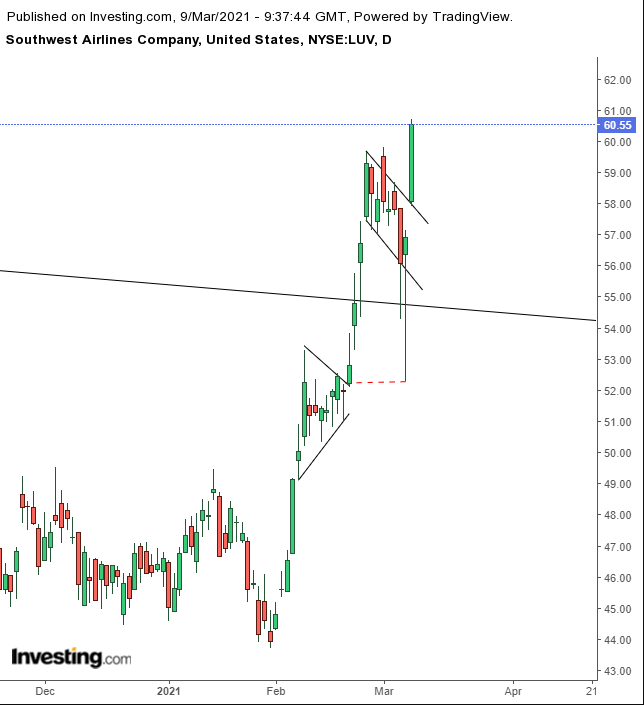For going on three weeks now we've been discussing the market's inflation 'conundrum'—the question of whether rising inflation will help or hinder economic growth. The most recent version of the narrative, exacerbated by escalating oil prices, says inflation could get in the way of a substantial recovery, as countries come out of lockdowns thanks to vaccines.
We, however, have been challenging that conclusion, based on a more nuanced take on recent market activity. We recognized that even during any hiatus in the selloff, investors continued rotating out of growth stocks such as big tech, whose valuation ballooned throughout the pandemic, moving instead into value sectors, which were pressured throughout lockdowns and social restrictions.
Yesterday, we provided a bearish call on the tech-heavy NASDAQ 100, the index which lists some of the most elite, mega cap tech shares. Today we're offering a bullish take on a beaten down travel stock, Southwest Airlines (NYSE:LUV), whose fortunes could be said to epitomize the current state of value shares.
As opposed to the broader market, which bottomed during March and then rebounded, Southwest only managed to begin coming back in May, after having reached its lowest level since January 2014. It stands to reason that if planes can't find passengers, the company won't profit. As such, the price bounced back only after finding support at the highs before the dotcom crash.
Since then, shares have been rising slowly, but have gained 38% since the low. The S&P 500 has rallied as much as 80% over the same period, more than double that of Southwest shares. But while the benchmark index fell almost 6% since its Feb. 16 high, it's still up a bit more than 3% so far this year. In comparison LUV, which closed yesterday at $60.55, its highest since October 2018, is up a bit more than 34% since the start of the year.
So, while the broader market is now in a downturn, Southwest is taking flight, and has exhausted only half the rebound move relative to the broader market.

The stock provided an upside breakout to a falling flag, bullish after the 7.5% jump in just four days. That was an upside breakout of a previous continuation pattern, a pennant. Notice how Friday’s low found support precisely by the breakout of the pennant.
The flag tilted downward as investors took profits following the sudden, sharp gains. The flag developed after the price cut through the downtrend line since its December 2017 record.
The flag bottom and Friday’s extreme low, a powerful hammer, developed right on top of that long-term downtrend line, demonstrating a supply-demand balance reversal. The fact that the price overcame the downtrend line from the record may further embolden bulls.
Trading Strategies
Conservative traders should wait for the price to retest the flag’s integrity.
Moderate traders would wait for a dip for a better entry, if not for evidence of support.
Aggressive traders could go long at will, provided they understand and accept the added risk. They should only do so after writing a coherent trading plan they commit to following.
Here’s just one example:
Trade Sample
- Entry: $59
- Stop-Loss: $57
- Risk: $2
- Target: $65
- Reward: $6
- Risk:Reward Ratio: 1:3
